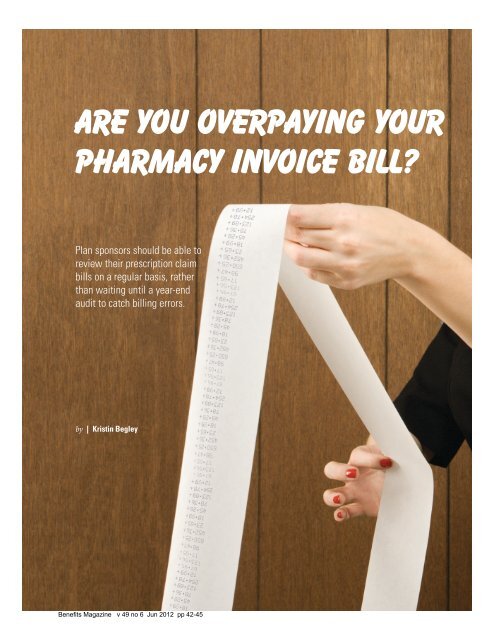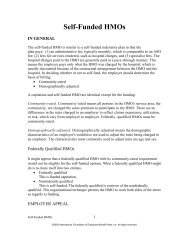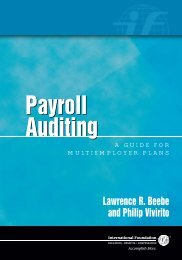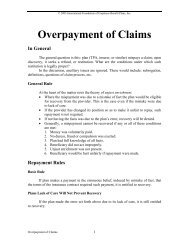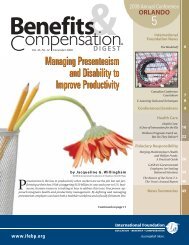Are You Overpaying Your Pharmacy Invoice Bill? - International ...
Are You Overpaying Your Pharmacy Invoice Bill? - International ...
Are You Overpaying Your Pharmacy Invoice Bill? - International ...
You also want an ePaper? Increase the reach of your titles
YUMPU automatically turns print PDFs into web optimized ePapers that Google loves.
<strong>Are</strong> <strong>You</strong> <strong>Overpaying</strong> <strong>You</strong>r<br />
<strong>Pharmacy</strong> <strong>Invoice</strong> <strong>Bill</strong>?<br />
Plan sponsors should be able to<br />
review their prescription claim<br />
bills on a regular basis, rather<br />
than waiting until a year-end<br />
audit to catch billing errors.<br />
by | Kristin Begley<br />
42<br />
benefits magazine june 2012<br />
Benefits Magazine v 49 no 6 Jun 2012 pp 42-45
Every two weeks, $12 billion of pharmacy<br />
benefit claims are paid to pharmacy<br />
benefit managers (PBMs) without<br />
a review to check the charges. It’s<br />
a bit like paying a credit card statement<br />
each month without reviewing it. Imagine<br />
requesting a statement from the credit company<br />
to check the bill, and being told the statement<br />
can be reviewed only during an end-of-year audit.<br />
Even if your bill contains errors, you must<br />
pay the whole bill and wait until the end of the<br />
year to dispute charges or receive a refund.<br />
Such is the case with pharmacy benefits. Plan<br />
sponsors usually receive their prescription claim<br />
bills every other week with only 48 hours to pay<br />
PBMs the amount due. Payers of pharmacy claims<br />
typically do not receive itemized statements of the<br />
claims. Even if an itemized statement is available,<br />
few payers have the resources to review complicated<br />
lengthy statements and confirm accuracy within 48<br />
hours.<br />
Prescription claim billing errors and overcharges<br />
do occur, and current billing methods can create<br />
payment errors that collectively could add up to<br />
enormous preventable overcharges each year.<br />
june 2012 benefits magazine 43
pharmacy benefits<br />
Protecting Against<br />
<strong>Invoice</strong> Errors<br />
Plan sponsors should consider each<br />
of the following six specifications for<br />
their PBM contract:<br />
1. The invoice review process does<br />
not fall under audit protocols.<br />
2. The PBM will provide unabridged<br />
claims data with an invoice.<br />
3. There are no limitations on the<br />
number of invoices that can be<br />
reviewed each year.<br />
4. All discounts (i.e., maximum allowable<br />
cost (MAC) and specialty<br />
drug lists)—rather than a sample<br />
of these discounts—will be disclosed<br />
to the payer.<br />
5. The PBM will review all disputed<br />
claims.<br />
6. The plan can withhold payment<br />
for disputed claims, or disputed<br />
claims will be reconciled within<br />
one invoice cycle.<br />
An example of bill review language<br />
that will protect a payer from overages<br />
is provided below.<br />
PBM shall allow Client and<br />
Client’s designated representative<br />
to review all invoices and all intakeaways<br />
>><br />
• Few payers are able to review complicated PBM statements and confirm accuracy within<br />
48 hours.<br />
• $307.4 billion was spent on drugs in the United States in 2010. A margin of error of 2-5%<br />
would mean $6 billion to $15 billion spent annually because of errors.<br />
• Contracts with PBMs should provide specific provisions for reviewing claims.<br />
• <strong>Bill</strong> review and an audit are not the same thing.<br />
Why <strong>Invoice</strong> Errors Occur<br />
The drug payment system in the<br />
United States is complex. Inherently,<br />
any large data set is likely to have errors<br />
when there are 200 to 500 columns<br />
of data per prescription in addition to<br />
some degree of human data input. To<br />
add to this, many PBMs process data on<br />
legacy systems where it is very difficult<br />
to capture the specificity of the contracts<br />
as they are negotiated, and it is<br />
rare that two contracts are adjudicated<br />
exactly the same. Additionally, as new<br />
plan designs are forced into legacy systems<br />
not designed for new strategies,<br />
processing errors can be compounded.<br />
Unchecked, the cost of payment errors<br />
can have a significant negative financial<br />
impact on plan sponsors that<br />
struggle to offer meaningful benefits.<br />
According to IMS, a provider of health<br />
care information, services and technology,<br />
about $307.4 billion was spent on<br />
drugs in the United States in 2010. With<br />
just a margin of error of from 2% to 5%,<br />
learn more >><br />
Education<br />
Specialty <strong>Pharmacy</strong> and Biotechnology Medication Coverage<br />
For more information, visit www.ifebp.org/elearning.<br />
From the Bookstore<br />
<strong>Pharmacy</strong> Benefits: Plan Design and Management<br />
by F. Randy Vogenberg. <strong>International</strong> Foundation. 2011.<br />
For more details, visit www.ifebp.org/books.asp?6962.<br />
plan sponsors and individuals combined<br />
are spending $6 billion to $15<br />
billion annually because of errors.<br />
No laws are in place to enforce<br />
transparency or accountability in drug<br />
spending. According to CMS, prescription<br />
drug costs are projected to grow<br />
at 7% year over year, and expenditures<br />
could double within ten years. 1<br />
Consequences of Not<br />
Being Able to Review <strong>Bill</strong>s<br />
Unlike credit card holders, who generally<br />
are not liable for errors on their<br />
bills, plan sponsors are responsible for errors<br />
on their prescription claim invoices.<br />
The consequences of overpaying a<br />
pharmacy benefits bill may be serious. If a<br />
payer is repeatedly invoiced for amounts<br />
greater than what was really owed and<br />
fails to catch the errors, health care costs<br />
will increase over time. Plan sponsors often<br />
shift costs to members, and these cost<br />
shifts end up hitting the pocketbooks of<br />
individual plan members.<br />
Some may argue that the type of errors<br />
being discussed here are negligible<br />
and simply a “rounding error”—a few<br />
cents here and a few cents there. But<br />
small prescription claims errors are<br />
like a death by a thousand cuts that<br />
collectively add up to a possible painful<br />
death of a prescription drug benefit.<br />
Although the absolute amount of each<br />
mistake may be small, collectively the<br />
potential overcharges can be expensive.<br />
For a midsize plan that pays $10 million<br />
per year for prescription drugs for<br />
6,000 employees, a 3% error rate could<br />
mean $300,000 in overcharges.<br />
44<br />
benefits magazine june 2012
pharmacy benefits<br />
formation pertaining to the Client’s pharmacy claims<br />
underlying such invoice. Such review shall, at Client’s<br />
option, be performed before payment of every invoice.<br />
PBM shall provide to Client and Client’s designated<br />
representative, with every invoice, the complete and<br />
unadulterated information pertaining to the Client’s<br />
pharmacy claims underlying such invoice (“Plan Data”),<br />
which shall include, but not be limited to: i) electronic<br />
files in plain text format, containing unabridged data<br />
records of each claim for which payment is sought by<br />
PBM, in an NCPDP 2 format; ii) a data dictionary describing<br />
the contents of the NCPDP claims data format<br />
provided; iii) electronic files in plain text format,<br />
containing any updates to the full and complete price<br />
lists, including NDCs or GPIs/GCNs 3 as applicable and<br />
price effective dates, each of which is used in pricing<br />
the claims submitted to Client for payment; this shall<br />
include, but not be limited to, maximum allowable cost<br />
(MAC) lists, specialty drug price lists, fixed cost or frozen<br />
cost drug lists, and/or any other price list applicable<br />
to and in force during the invoice period; and iv) electronic<br />
files in plain text format, containing updates, if<br />
any, to the list of drugs excluded from guarantees or<br />
pricing terms (e.g. new to market generics). Beginning<br />
within thirty (30) days of any written request to PBM<br />
by Client, and continuing until Client delivers written<br />
notice changing this directive, PBM shall deliver the requested<br />
Plan Data without fee and contemporaneously<br />
with the delivery of each invoice.<br />
In the event that Client determines that there are errors<br />
or inaccuracies in the invoice or underlying Plan<br />
Data, Client shall pay the full amount of the invoice<br />
less any disputed amount. Client will notify PBM, in<br />
writing, of the source and amounts in dispute, and Client<br />
will submit to PBM sufficient detail, back-up and/<br />
or data to support its dispute. PBM and Client shall<br />
work in good faith to reconcile any disputes. Withholding<br />
disputed amounts shall not constitute default<br />
by Client and shall not entitle the PBM to suspend or<br />
delay its performance of services.<br />
Unfortunately, PBMs often state that bill review and an<br />
audit are the same thing and cite that the contract does, indeed,<br />
allow for review in the form of an audit.<br />
It is important to recognize that reviewing an invoice prepayment<br />
is not the same as performing an audit. An invoice<br />


